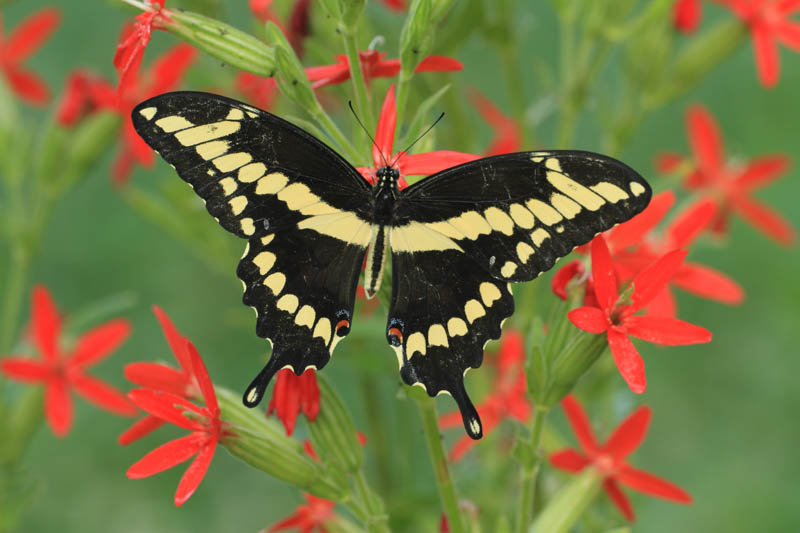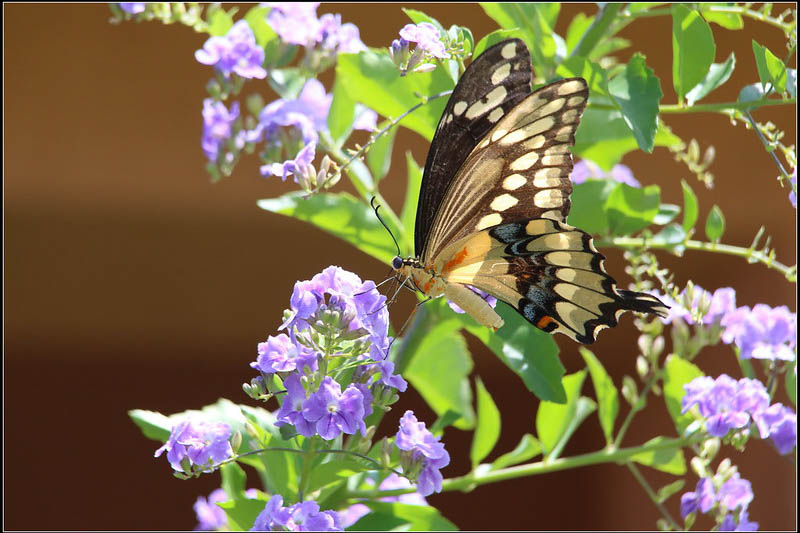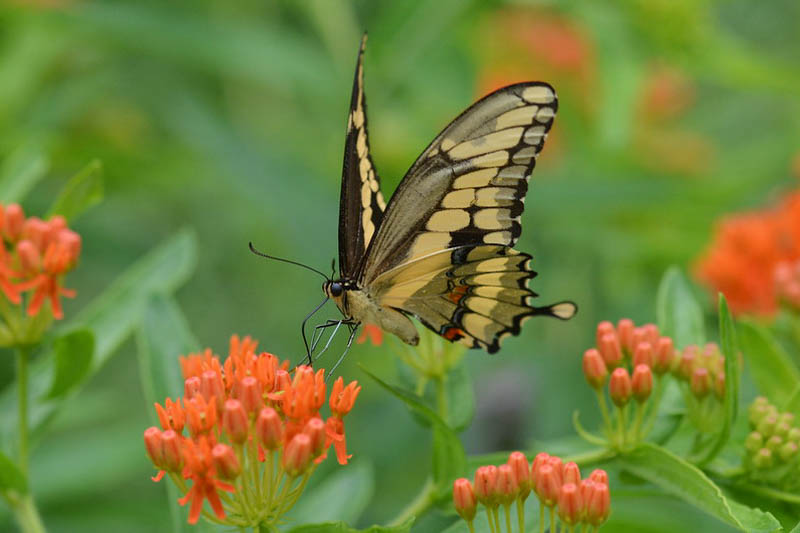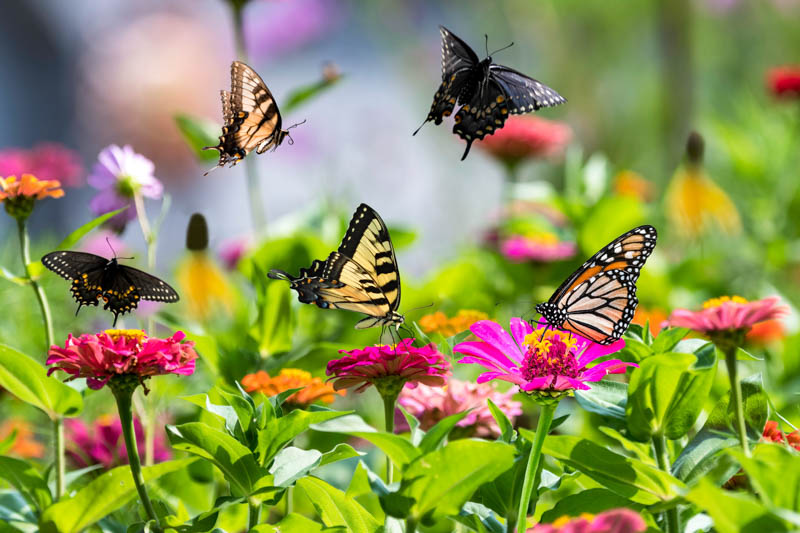Papilio cresphontes
The Giant Swallowtail Butterfly (Papilio cresphontes) is one of the largest and most striking butterflies found in various regions of North America. Currently, it is not considered endangered or threatened, but like many species, it is susceptible to habitat loss and the use of pesticides.
The Giant Swallowtail, known as the largest butterfly in North America, is predominantly found in various regions across the eastern part of the continent. Its range includes:
Eastern North America: The butterfly is abundant in many areas of eastern North America, where it is a common sight in various habitats.
United States: Within the United States, it is especially prevalent in the southeastern states but extends northward to parts of New England and the Great Lakes region.
Canada: In Canada, the Giant Swallowtail’s range includes southern areas of Ontario and Quebec, where it has been observed more frequently in recent years.
Habitats: This species thrives in diverse environments, including woodlands, citrus groves, gardens, and wetlands, particularly where host plants for their larvae, such as citrus trees, rue, and prickly ash, are available.
It’s important to note that populations of swallowtails found in western North America and extending into Panama, previously considered part of Papilio cresphontes, have been reclassified as a separate species, Papilio rumiko, as of 2014. This reclassification highlights the dynamic nature of species identification and distribution in entomology.

Giant Swallowtail Butterfly on Royal Catchfly (Silene regia)
The Giant Swallowtail possesses a distinct and striking appearance:
Wingspan: It boasts an impressive wingspan ranging from 4 to 7 inches (10 to 18 cm), making it immediately recognizable.
Color and Pattern: The wings display a dramatic coloration of deep black with bold yellow bands and spots. This pattern provides a stark contrast and makes the butterfly highly visible.
Wing Shape: The wings have a unique shape with elongated tails on the hindwings, resembling the tails of swallows, hence the name “Swallowtail”.
Underside of Wings: The underside of the wings is predominantly yellow with black and blue markings, along with a row of orange spots near the tail, adding to its striking appearance.
Body: The body of the Giant Swallowtail is robust and dark in color, complementing its wings.
Sexual Dimorphism: There is some variation between males and females. Females typically have a slightly larger size and may have more rounded wings, while males often have more pronounced yellow markings.
Caterpillar Appearance: Before reaching this majestic adult stage, the caterpillar is equally distinctive. It mimics a bird dropping for camouflage, being brown or black and white.
The courtship and mating rituals of the Giant Swallowtail butterfly are intricate and fascinating, showcasing unique behaviors characteristic of this species:
Courtship Flight: The courtship process often begins with the male Giant Swallowtail performing a special flight pattern to attract a female. This involves a series of aerial maneuvers, including swooping and fluttering around the female, displaying his agility and strength.
Pheromone Release: Males may release pheromones to entice females. These chemical cues are crucial in signaling the male’s presence and readiness to mate.
Tactile Interaction: As part of the courtship, the male may engage in tactile behaviors, such as gently touching the female with his legs or antennae. This form of physical interaction is common among many butterfly species and helps to stimulate the female.
Mating: Mating will occur if the courtship is successful and the female is receptive. The pair will join at their abdomens and can remain coupled for an extended period, which may last from several minutes to hours.
Egg Laying: After mating, the female will lay her eggs on suitable host plants. In the case of the Giant Swallowtail, these are often citrus trees or plants from the rue family.
Multiple Mating: Females may mate multiple times throughout their lifespan, which can influence the genetic diversity of their offspring.

The life cycle of the Giant Swallowtail butterfly is a remarkable example of complete metamorphosis, encompassing four distinct stages: egg, caterpillar (larva), pupa (chrysalis), and adult butterfly. Each stage plays a crucial role in the development of this magnificent butterfly:
Egg Stage: The cycle begins when the female Giant Swallowtail lays her eggs, typically on the leaves of host plants like citrus trees or rue. The eggs are small and spherical, usually yellowish or orange in color. The caterpillar can become a significant pest in citrus farms, which earned it the names orange dog or orange puppy.
Caterpillar Stage: Once the eggs hatch, the caterpillar emerges. These larvae are unique in appearance, resembling bird droppings as a form of camouflage to protect against predators. They feed voraciously on the leaves of their host plants, growing rapidly and molting several times.
Pupa Stage: After reaching a certain size and developmental stage, the caterpillar forms a chrysalis. This pupa stage is a time of significant transformation, where the organism reorganizes into the adult butterfly. The chrysalis is typically brown or green, blending into the surrounding environment.
Adult Butterfly Stage: The final stage is the emergence of the adult Giant Swallowtail butterfly. Distinguished by its large size and striking black and yellow markings, the butterfly will allow its wings to dry and harden after emerging from the chrysalis. Once its wings are fully expanded and dry, the butterfly begins its life of flight, feeding on nectar from various flowers.
The duration from egg to adult butterfly can vary but typically spans several weeks to a couple of months, depending on environmental conditions like temperature and food availability. The Giant Swallowtail can have multiple generations yearly, especially in warmer climates. Each stage of this life cycle contributes to the survival and success of the species in its environment.
|
|
|
The diet of the Giant Swallowtail butterfly varies significantly between the caterpillar and adult stages, each adapted to different nutritional needs:
Caterpillar (Larva): Giant Swallowtail caterpillars primarily feed on the leaves of plants in the citrus family, like orange, lemon, lime, and grapefruit trees. They are also known to eat the leaves of other plants, such as rue (Ruta graveolens), prickly ash (Zanthoxylum americanum), or hoptree (Ptelea trifoliata). These plants provide essential nutrients for the caterpillars’ growth and development.
Adult Butterfly: After metamorphosis, the diet shifts to nectar from flowers. Adult Giant Swallowtails visit a wide range of flowering plants to feed on nectar, which supplies them with energy. They are attracted to flowers with abundant nectar, such as lantana, azalea, bougainvillea, soapwort (Saponaria officinalis), goldenrod (Solidago), Japanese honeysuckle (Lonicera japonica), and swamp milkweed (Asclepias incarnata).
In both stages, food choice plays a crucial role in their survival and ability to reproduce. The caterpillars rely on specific host plants for their development, while the adults need a variety of nectar sources to sustain their energy for activities like flying, mating, and laying eggs.

Flight Pattern: The Giant Swallowtail is known for its strong and graceful flight. It has a distinctive style of flying that includes powerful wing beats and gliding, which makes it quite a sight in gardens and natural habitats.
Migration: Unlike some butterfly species that undertake long-distance migrations, like monarch butterflies, the Giant Swallowtail does not typically engage in extensive migratory behavior. However, it may exhibit local or regional movements in response to changes in weather, availability of food sources, and suitable habitat.
Seasonal Range Expansion: In warmer months, Giant Swallowtails may expand their range slightly, particularly in the northern parts of their distribution. This expansion is generally driven by the availability of suitable host plants for their caterpillars and favorable climate conditions.
Overwintering: The overwintering strategy of the Giant Swallowtail depends on its geographic location. In the northern parts of its range, where temperatures drop significantly, the butterflies overwinter in the pupal stage (as chrysalises), entering a state of diapause (dormancy) until the weather warms up. In contrast, adults may remain active year-round in warmer southern regions, and the lifecycle continues without a dormant period.
The Giant Swallowtail butterfly, like many butterfly species, faces a variety of predators throughout its life cycle, from the caterpillar stage to the adult butterfly. These predators include:
Birds: Birds are primary predators of the Giant Swallowtail, especially targeting the adult butterflies. The butterfly’s bright coloration can serve as a warning to some bird species about potential unpalatability.
Spiders: Spiders can capture and consume Giant Swallowtails, particularly adults that get trapped in their webs.
Parasitic Wasps and Flies: The Giant Swallowtail is vulnerable to parasitic wasps and flies in the caterpillar stage. These insects lay their eggs on or inside the caterpillars, and the larvae that emerge feed on the caterpillar, often leading to its death.
Small Mammals: Mice, squirrels, and other small mammals may prey on Giant Swallowtail caterpillars and chrysalises.
Reptiles and Amphibians: Frogs, lizards, and some snakes are known to eat butterflies and can pose a threat to the Giant Swallowtail.
Insect Predators: Other insects, such as ants and larger predatory beetles, can prey on the eggs and young caterpillars of the Giant Swallowtail.
The Giant Swallowtail has developed various defense mechanisms to reduce predation risks. The caterpillar’s appearance mimics bird droppings, providing camouflage, and the adult’s bright coloration can warn of potential toxicity. Despite these defenses, predation is a natural and essential part of their life cycle, contributing to the ecological balance in their habitats.

Creating a haven for Giant Swallowtail butterflies involves providing the necessary resources for both their caterpillars and adult butterflies. Here’s how you can attract them to your garden:
Plant Host Plants for Caterpillars: Since Giant Swallowtail caterpillars primarily feed on citrus plants (like orange, lemon, and grapefruit) and other plants such as rue (Ruta graveolens), prickly ash (Zanthoxylum americanum), or hoptree (Ptelea trifoliata), planting these in your garden will encourage female butterflies to lay eggs. These host plants are crucial for caterpillar development.
Provide Nectar Sources for Adults: Adult Giant Swallowtails feed on nectar from a variety of flowers. Planting nectar-rich flowers like lantana, azalea, bougainvillea, soapwort, goldenrod, Japanese honeysuckle, and swamp milkweed will attract adult butterflies. Ensure these plants bloom at different times during the growing season to provide a continuous nectar supply.
Create a Butterfly-Friendly Environment: Butterflies need sunny spots to bask and open areas to fly. Ensure your garden has both sunny and shaded areas, with some flat stones or other surfaces for the butterflies to rest and warm themselves in the sun.
Offer Water Sources: Butterflies need water but prefer shallow sources. A birdbath with a few stones to land on or a shallow dish with damp sand will provide them with the necessary moisture.
Avoid Pesticides: Pesticides can harm butterflies and caterpillars. Use natural pest control methods and avoid chemical pesticides to keep your garden safe for butterflies.
Provide Shelter: Dense shrubbery or tall grasses can offer shelter from predators and harsh weather, creating a safe habitat for butterflies.
Garden Maintenance: Allow some wildness in your garden. Overly manicured lawns and gardens can reduce the habitat’s suitability for butterflies. Let some areas grow naturally to provide habitats for caterpillars and pupae.
Educational and Observational Opportunities: Learn about the Giant Swallowtail’s life cycle and preferences. Observing which plants they are attracted to in your garden can help you make it even more butterfly-friendly.
Create a membership account to save your garden designs and to view them on any device.
Becoming a contributing member of Gardenia is easy and can be done in just a few minutes. If you provide us with your name, email address and the payment of a modest $25 annual membership fee, you will become a full member, enabling you to design and save up to 25 of your garden design ideas.
Join now and start creating your dream garden!
Create a membership account to save your garden designs and to view them on any device.
Becoming a contributing member of Gardenia is easy and can be done in just a few minutes. If you provide us with your name, email address and the payment of a modest $25 annual membership fee, you will become a full member, enabling you to design and save up to 25 of your garden design ideas.
Join now and start creating your dream garden!